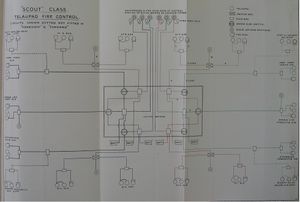Boadicea Class Cruiser (1908)
The two scout cruisers of the Boadicea Class were completed by 1910.
| Overview of 2 vessels | |||||
|---|---|---|---|---|---|
| Citations for this data available on individual ship pages | |||||
| Name | Builder | Laid Down | Launched | Completed | Fate |
| Boadicea | Pembroke Royal Dockyard | 1 Jun, 1907 | 14 May, 1908 | Jun, 1909 | Sold 13 Jul, 1926 |
| Bellona | Pembroke Royal Dockyard | 5 Jun, 1908 | 20 Mar, 1909 | Feb, 1910 | Sold 9 May, 1921 |
Contents
Habitability
In 1912 and 1913, four Bastian Radiators were obtained for a temporary trial in warming the Officers' Cabins on the Upper Deck where radiators were not already present. Based on the satisfactory reports, these radiators were kept in place permanently.[1]
Boats
The ships were ordered in July 1914 to surrender their 13.5 foot dinghy unless they'd already returned their Balsa Raft – they were not to carry both.[2]
Rangefinders
In January 1914, it was reported that a rangefinder mounted on the fore upper bridge may have been unable to work properly when the ships were steaming at high speeds. Whether this was due to vibration or spray is not made clear.[3] At the same time, it was worried that a rangefinder mounted aft had a forward arc of view obstructed by boats.[4]
Armament
Guns
This section sourced from The Sight Manual, 1916.[5]
The six 4-in guns were 4-in B.L. Mark VII guns on P. IV mountings.
The mounting could elevate to 15 degrees and depress to 10 degrees, but though its sight could match the 15 degree elevation, the range dial was only graduated to 8,500 yards (8.5 degrees) at 2,225 fps. This might have been in obeisance to the Admiralty's stated desire that giving a long-ranged gun to a light cruiser is a guarantee that it will go get in a gunfight and abandon its scouting duties.[Inference][Citation needed]
The gear-worked sights, the first F.T.P. models to be introduced, had a range gearing contant of 42.95 and spiral-reading range dials for 2850 fps, 1-in aiming rifle and .303-in aiming rifle. MV could be corrected (downward only) 200 fps by adjustable scale plate.
The deflection gearing constant was 61.7 with 1 knot equal to 2.74 arc minutes, corresponding to 2824 fps at 3500 yards. Drift was corrected by inclining the sight 2 degrees.
The layer's sight line was 16.8 inches above the bore, and 15 inches left. The trainer's lines were 16.8 inches above and 14.9 inches right.
The sight lacked a "C" corrector. A number of temperature scale plates corresponding to M.V.s varying by 25 fps could be shipped with an index facing the actual M.V..
Open sights do not seem to be in the drawing.
In October 1913, it was decided that the mountings should also have buzzer for their firing circuits.[6]
Control Groups

In 1909, these were described as being similar to the Gem class, but the forecastle and poop guns could be controlled as separate groups or attached to the nearest broadside group on either side. The middle line guns could be connected to whichever side was desired.[8]
Directors
Main Battery
Secondary Battery
Torpedo Control
In 1907, Boadicea (and perhaps Bellona), Swift and the River class destroyers were to be equipped with Fore Bridge Firing Gear.[9]
Transmitting Stations
Dreyer Table
These ships had no fire control tables.[10]
Fire Control Instruments

By 1909, both in this class were outfitted with the latest Vickers F.T.P. Fire Control Instruments (Mark I in Boadicea, Mark II in Bellona), marking a new wrinkle in equipment by replacing the Barr and Stroud equipment that had taken hold shortly after 1906. The equipment was fitted as follows:[12][13]
- Range Transmitters: 3
- Deflection Transmitters: 3
- Range Receivers: 6
- Deflection Receivers: 6
- C.O.S.: 1
- Vickers Fire Gongs: 6 with 3 keys
None of the ships had Target Visible or Gun Ready signals.[14]
Alterations
By November 1918 the two ships along with the two Blonde class scouts were fitted with rails for 66 mines. The torpedo tubes and guns removed when the mines were shipped could be placed back aboard with enough notice.[15]
See Also
Footnotes
- ↑ Admiralty Weekly Order No. 600 of 24 October 1913.
- ↑ Admiralty Weekly Order No. 131 of 10 July 1914.
- ↑ Admiralty Weekly Order No. 790 of 9 Jan, 1914.
- ↑ Admiralty Weekly Order No. 791 of 9 Jan, 1914.
- ↑ The Sight Manual, 1916. pp. 7, 87, 108, Plate 40.
- ↑ Admiralty Weekly Order No. 569 of 17 Oct, 1913.
- ↑ Handbook for Fire Control Instruments, 1909. Plate 54.
- ↑ Handbook for Fire Control Instruments, 1909. pp. 51-52.
- ↑ Annual Report of the Torpedo School, 1907. p. 31. Its design was detailed in Annual Report of the Torpedo School, 1906, p. 28.
- ↑ Handbook of Captain F. C. Dreyer's Fire Control Tables, 1918. p. 3.
- ↑ Handbook for Fire Control Instruments, 1909. Plate 52.
- ↑ Handbook for Fire Control Instruments, 1909. pp. 57, 60.
- ↑ Annual Report of the Torpedo School, 1909. p. 148.
- ↑ Handbook for Fire Control Instruments, 1914. p. 11.
- ↑ Annual Report of the Torpedo School, Mining Appendix, 1917-18. p. 11. Plate 7.
Bibliography
- Admiralty, Gunnery Branch (1910). Handbook for Fire Control Instruments, 1909. Copy No. 173 is Ja 345a at Admiralty Library, Portsmouth, United Kingdom.
- Admiralty, Gunnery Branch (1918). Handbook of Captain F. C. Dreyer's Fire Control Tables, 1918. C.B. 1456. Copy No. 10 at Admiralty Library, Portsmouth, United Kingdom.
| Boadicea Class Scout Cruiser | |||||||||||||||||||||||||||||||||||||||||||||||||||||||||||||||||||||||||||||||||||||||||||||||||||||||||||||||||||||||
| Boadicea Group | |||||||||||||||||||||||||||||||||||||||||||||||||||||||||||||||||||||||||||||||||||||||||||||||||||||||||||||||||||||||
| Boadicea | Bellona | ||||||||||||||||||||||||||||||||||||||||||||||||||||||||||||||||||||||||||||||||||||||||||||||||||||||||||||||||||||||
| Blonde Group | |||||||||||||||||||||||||||||||||||||||||||||||||||||||||||||||||||||||||||||||||||||||||||||||||||||||||||||||||||||||
| Blonde | Blanche | ||||||||||||||||||||||||||||||||||||||||||||||||||||||||||||||||||||||||||||||||||||||||||||||||||||||||||||||||||||||
| Active Group | |||||||||||||||||||||||||||||||||||||||||||||||||||||||||||||||||||||||||||||||||||||||||||||||||||||||||||||||||||||||
| Active | Amphion | Fearless | |||||||||||||||||||||||||||||||||||||||||||||||||||||||||||||||||||||||||||||||||||||||||||||||||||||||||||||||||||||
| <– | Sentinel Class | Minor Cruisers (UK) | Bristol Class | –> | |||||||||||||||||||||||||||||||||||||||||||||||||||||||||||||||||||||||||||||||||||||||||||||||||||||||||||||||||||